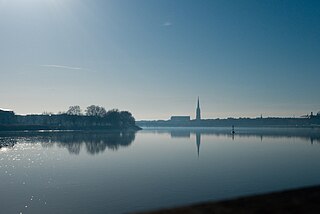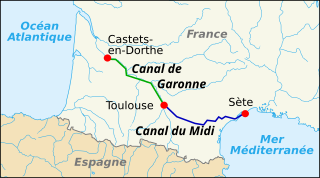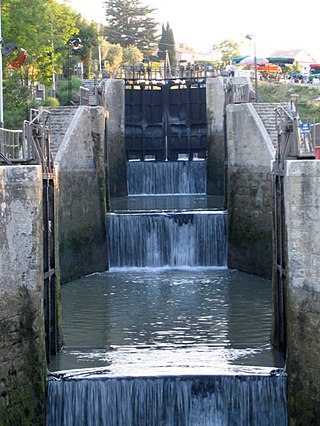
The Ecluse Saint-Pierre is one of two locks on the Canal de Brienne. [1] Also known as Garonne lock, in French : Ecluse de Garonne. [2]

The Ecluse Saint-Pierre is one of two locks on the Canal de Brienne. [1] Also known as Garonne lock, in French : Ecluse de Garonne. [2]

The Garonne is a river that flows in southwest France and northern Spain. It flows from the central Spanish Pyrenees to the Gironde estuary at the French port of Bordeaux – a length of 529 km (329 mi), of which 47 km (29 mi) is in Spain ; the total length extends to 602 km (374 mi) if one includes the Gironde estuary between the river and the sea. Its basin area is 56,000 km2 (22,000 sq mi), which increases to 84,811 km2 (32,746 sq mi) if the Dordogne River, which flows from the east and joins the Garonne at Bec d'Ambès to form the Gironde estuary, is included.

Toulouse is the prefecture of the French department of Haute-Garonne and of the larger region of Occitania. The city is on the banks of the River Garonne, 150 kilometres from the Mediterranean Sea, 230 km (143 mi) from the Atlantic Ocean and 680 km (420 mi) from Paris. It is the fourth-largest city in France after Paris, Marseille and Lyon, with 504,078 inhabitants within its municipal boundaries (2021); its metropolitan area has a population of 1.5 million inhabitants (2021). Toulouse is the central city of one of the 22 metropolitan councils of France. Between the 2014 and 2020 censuses, its metropolitan area was the third fastest growing among metropolitan areas larger than 500,000 inhabitants in France.

The Canal du Midi is a 240 km (150 mi) long canal in Southern France. Originally named the Canal Royal en Languedoc and renamed by French revolutionaries to Canal du Midi in 1789, the canal is considered one of the greatest construction works of the 17th century.

La Dépêche, formally La Dépêche du Midi, is a regional daily newspaper published in Toulouse in Southwestern France with seventeen editions for different areas of the Midi-Pyrénées region. The main local editions are for Toulouse, Ariège, Aude, Aveyron, Haute-Garonne, Gers, Lot, Lot-et-Garonne, Hautes-Pyrénées, Tarn and Tarn-et-Garonne.

Castelnaudary is a commune in the Aude department in the Occitanie region of southern France. It is located in the former province of the Lauragais and famous for cassoulet of which it claims to be the world capital, and of which it is a major producer.

The Briare Canal is one of the oldest canals in France. Its construction started in 1604. It was the first summit level canal in Europe that was built using pound locks, connecting the Rhone-Saône and Seine valleys. It is 57 kilometres long and is part of the Bourbonnais route from Saint-Mammès on the Seine to Chalon-sur-Saône on the Saône.

Moissac is a commune in the Tarn-et-Garonne department in the Occitanie region in southern France. The town is situated at the confluence of the rivers Garonne and Tarn at the Canal de Garonne. Route nationale N113 was constructed through the town and between Valence-d'Agen and Castelsarrasin. It is served by Moissac station on the Bordeaux-Toulouse line.

The Canal des Deux Mers has been used to describe two different but similar things since the 1660s. In some cases, it is used interchangeably with the Canal du Midi. In others, it describes the path from the Atlantic to the Mediterranean of which the Canal du Midi was the first artificial component.

Fonseranes Locks are a flight of staircase locks on the Canal du Midi near Béziers.

The Canal de Garonne, formerly known as Canal latéral à la Garonne, is a French canal dating from the mid-19th century that connects Toulouse to Castets-en-Dorthe. The remainder of the route to Bordeaux uses the river Garonne. It is the continuation of the Canal du Midi which connects the Mediterranean with Toulouse.

The Canal de Brienne, also known as Canal de Saint-Pierre, is a French canal connecting the Garonne River with the Canal du Midi and the Canal de Garonne. It has two locks. The lock opening to the Garonne is known as Ecluse Saint-Pierre. The lock nearer to the Canal du Midi usually stands open.

There are 91 working locks on the Canal du Midi along its 240-kilometre (150 mi) course from the Bassin du Thau on the Mediterranean coast to the junction with the Canal lateral a la Garonne in Toulouse. There are a further 13 locks on the 37-kilometre (23 mi) La Nouvelle branch which runs through Narbonne to the Mediterranean at Port-la-Nouvelle. The locks are all under the management of the French navigation authority, Voies navigables de France.

Négra Lock is a single chamber lock on the Canal du Midi near the village of Villefranche-de-Lauragais in Languedoc, France. There is a small chapel at the lock and also a small red-brick aqueduct which carries the canal over the Thésauque, a tributary of the Hers.

The Bassin de Saint-Ferréol was created as the result of a large earth dam across the mouth of the valley of Laudot stream at St. Ferréol in the Montagne Noire. It was originally proposed by Chevalier de Clerville and accepted by Pierre Paul Riquet as an integral part of the Canal du Midi. Riquet needed to provide a sufficient water reservoir to allow the locks to function year round, even in the dry summer season. The dam was begun on 15 April 1667 and was completed in four years. It was the first dam built specifically to supply water to a navigable canal and was by far the greatest single work of civil engineering undertaken during the building of the Canal du Midi.

The Agde Round Lock is a canal lock on the Canal du Midi that connects to the Hérault River in Agde, France. It is almost unique because it is round, which allows a boat to turn around, and the fact that it has three sets of lock gates, each with a different water level. It was built in 1676 of volcanic stone and was originally 29.20 m in diameter, 5.20 m deep.

The Seuil de Naurouze, or Col de Naurouze, is the highest point of the Canal du Midi in southern France. It is the watershed point identified by Pierre-Paul Riquet when he designed and built the canal. Water falling on the western side of this point flows to the Atlantic Ocean and on the eastern side to the Mediterranean Sea. It is on the border of the department of Haute-Garonne and the department of the Aude.

The Ponts Jumeaux is the point at which the Canal du Midi joins the Canal de Garonne and the River Garonne, via the Canal de Brienne. It was built in 1774 by Joseph-Marie de Saget, a civil engineer in the province of Languedoc in Toulouse.

The Port de l'Embouchure is one of the two ports located in Toulouse on the Canal du Midi. The other being the Port Saint-Sauveur. This port is located in the basin at the Ponts Jumeaux. From the basin are found the entrances to the canals Canal de Garonne, Canal du Midi and Canal de Brienne.
The balancing of incoming and outgoing water allows the Canal du Midi to operate as it does. Each time a lock operates, large quantities of water are either required to fill it or dump from it into the lower level pound. There must be a constant source of water in order to fill and the excess water dumped must have a place to exit the canal without it overflowing. Being able to provide this water source was one of the most important problems to be solved by Pierre Paul Riquet, its creator.

Rosa is a French hotel barge of Dutch origin. Since 1990 she has been offering cruises to international tourists on the Canal de Garonne in the Nouvelle Aquitaine region of South West France. The waterway authority Voies Navigables de France reported in 2014 that there were around 80 hotel barges operating on the inland waterways. They keep alive the tradition of the boatmen (mariniers) whose numbers have declined in number from thousands in the post-World War II years to just a few hundred today.